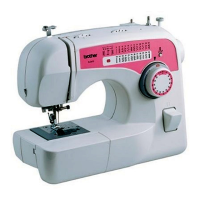What to do if the sewing light bulb does not come on in my Brother Sewing Machine?
- Mmichelle55Sep 13, 2025
If the sewing light bulb on your Brother Sewing Machine does not come on, replace the sewing light bulb.

What to do if the sewing light bulb does not come on in my Brother Sewing Machine?
If the sewing light bulb on your Brother Sewing Machine does not come on, replace the sewing light bulb.
| Type | Mechanical |
|---|---|
| Maximum Stitch Width | 5 mm |
| Maximum Stitch Length | 4 mm |
| Free Arm | Yes |
| Stitch Options | 25 |
| Buttonhole Styles | 1-step |
| Feed Dog | 6 |
| Accessories Included | bobbins, screwdriver, seam ripper |
| Bobbin Type | Top drop-in |
| Needle Threading System | Automatic needle threader |
Covers DANGER and WARNING guidelines to prevent electric shock, burns, fire, and injury.
Instructions for safe unpacking, use, maintenance, and repair of the sewing machine.
Identifies and describes the key components of the sewing machine.
Lists and describes the standard accessories included with the sewing machine.
Instructions for connecting the foot controller and power supply to the machine.
Explains how to turn the machine's main power and sewing light on and off.
Guidance on how to check if the sewing needle is straight and sharp.
Step-by-step instructions for safely replacing the sewing needle.
Instructions for safely changing the presser foot for different sewing tasks.
Instructions for using the flat bed attachment to store accessories.
How to convert the machine to a free-arm style for sewing tubular areas.
Explains the function of various dials and levers for stitch selection and adjustment.
Step-by-step instructions for winding the bobbin and threading the upper and lower threads.
Guidance on selecting appropriate needles, threads, and fabrics for optimal sewing results.
Essential safety precautions and tips to follow before starting straight and zigzag stitching.
Instructions for setting up and performing straight stitching.
Instructions for setting up and performing zigzag stitching.
Instructions for creating a blind hem stitch for neat fabric edges.
How to use the shell tuck stitch for decorative picot edges on lightweight fabric.
Techniques for using the elastic stitch for mending, sewing elastic, or joining fabric.
Guidance on using stitches for joining fabric pieces, like in patchwork.
Instructions for using stitches to join fabric with a space between edges.
How to use overlock stitches for joining and finishing stretch materials.
Using the feather stitch as a decorative top stitch for hemming and embellishments.
Using the triple zigzag stitch for heavyweight stretch fabrics or decorative top stitching.
Instructions for using various stitches for decorative top stitching and smocking.
Step-by-step guide to creating automatic buttonholes using the buttonhole foot.
Special techniques for sewing buttonholes on stretch fabrics using a gimp thread.
How to adjust stitch length and fine-adjustment screw for buttonhole accuracy.
Instructions for attaching buttons using the zigzag stitch and button sewing foot.
How to use the zipper foot to insert zippers into fabric.
Method for gathering fabric by sewing loose straight stitches and pulling threads.
Instructions for darning fabric using the darning plate and straight stitch.
Creating fabric appliqués by sewing cut shapes with a zigzag stitch.
Guidance for adding monograms and decorative embroidery to fabric.
Instructions for using the walking foot to sew difficult-to-feed materials like vinyl.
How to use the quilting foot for darning and free-motion machine quilting.
Guidance on using the 1/4-inch quilting foot for accurate quilt piecing seams.
Procedures for changing the light bulb and cleaning the sewing machine.
A guide to diagnosing and resolving common issues with the sewing machine.